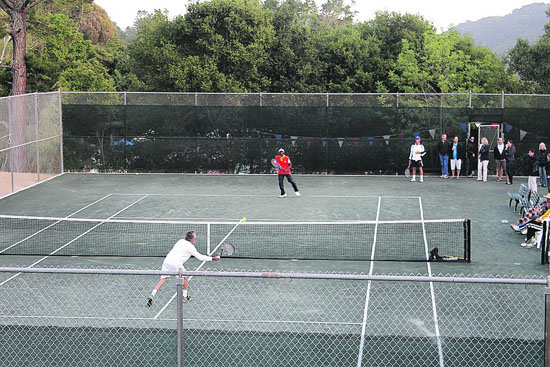|
|
Published July 2nd, 2014
|
Clay Courts come to Lamorinda
|
|
| By Marissa Harnett |
 |
| Photos provided |
Longer rallies, a forgiving surface, the ability to slide. These are just a few of the benefits of playing tennis on clay courts. Although standard in Europe (red clay) and common on the east coast (green clay), clay courts are anomalies in the west.
 In May, the Moraga Valley Swim and Tennis Club in Orinda completed the installation of two Har-Tru (green clay) courts, making them the only clay courts in the East Bay at the club level.
In May, the Moraga Valley Swim and Tennis Club in Orinda completed the installation of two Har-Tru (green clay) courts, making them the only clay courts in the East Bay at the club level.
 Easier to maintain than its red clay counterpart, Har-Tru is actually composed of crushed stone. The first court of its kind was built in 1931 in Hagerstown, Md., and by the 1970s, this new surface became wildly popular in the east and south. The trend stopped short of the west, however. Only 1 percent of tennis courts in California are clay compared to 50 percent of courts in Florida. Resurgence in the popularity of Har-Tru, combined with improved strategies for keeping the clay moist, has slowly delivered the green clay to the west. Still, it has been installed mostly at private residences.
Easier to maintain than its red clay counterpart, Har-Tru is actually composed of crushed stone. The first court of its kind was built in 1931 in Hagerstown, Md., and by the 1970s, this new surface became wildly popular in the east and south. The trend stopped short of the west, however. Only 1 percent of tennis courts in California are clay compared to 50 percent of courts in Florida. Resurgence in the popularity of Har-Tru, combined with improved strategies for keeping the clay moist, has slowly delivered the green clay to the west. Still, it has been installed mostly at private residences.
 MVP tennis pro, Scott Borowiak, who played a major role in acquiring the clay, is excited to finally have them at the club. While hard courts don't last long before they need repairs, clay courts are built to last because they are dynamic. "MVP, like many, many other clubs in northern California, has problems with asphalt courts that crack due to earth movements," explained Borowiak. "Clay courts do not crack and last for 20 to 30 years with only minor repairs necessary."
MVP tennis pro, Scott Borowiak, who played a major role in acquiring the clay, is excited to finally have them at the club. While hard courts don't last long before they need repairs, clay courts are built to last because they are dynamic. "MVP, like many, many other clubs in northern California, has problems with asphalt courts that crack due to earth movements," explained Borowiak. "Clay courts do not crack and last for 20 to 30 years with only minor repairs necessary."
 Many members are surprised by the difference. The clay allows athletes to play longer. "I like it more than I thought I would," said member Julia Grimsrud. "It's not as hot and it's easier on my knees."
Many members are surprised by the difference. The clay allows athletes to play longer. "I like it more than I thought I would," said member Julia Grimsrud. "It's not as hot and it's easier on my knees."
 From the standpoint of developing future champions, MVP tennis director Heather Randolph is thrilled to add clay courts to the club's Junior Program. "It is widely thought that clay is the best surface to learn tennis on," she said.
From the standpoint of developing future champions, MVP tennis director Heather Randolph is thrilled to add clay courts to the club's Junior Program. "It is widely thought that clay is the best surface to learn tennis on," she said.
 Most of the world's top players train from a young age on clay. The United States Tennis Association is even starting to acknowledge the importance of training on clay.
Most of the world's top players train from a young age on clay. The United States Tennis Association is even starting to acknowledge the importance of training on clay.
 "It shows them (juniors) how to understand the construction of a point, and it gets them to understand what you need (in order) to have longevity in a point," Randolph said.
"It shows them (juniors) how to understand the construction of a point, and it gets them to understand what you need (in order) to have longevity in a point," Randolph said.
 On clay, the ball typically moves slower. This allows the player more time to reach and return it, thereby making points last longer. "On clay it is not so easy to hit a winner. Usually it takes a combination of good shots to get the opponent in enough trouble to finish the points," said Randolph. "Clay court play develops toughness, stamina, patience and strategy that hard court play does not."
On clay, the ball typically moves slower. This allows the player more time to reach and return it, thereby making points last longer. "On clay it is not so easy to hit a winner. Usually it takes a combination of good shots to get the opponent in enough trouble to finish the points," said Randolph. "Clay court play develops toughness, stamina, patience and strategy that hard court play does not."
 All early signs suggest that the clay courts have been a worthwhile investment for both MVP and the tennis world. "We're getting calls from all over the Bay Area to come play on the clay, especially kids who want to train for national events," Borowiak said. "It's been an exciting time."
All early signs suggest that the clay courts have been a worthwhile investment for both MVP and the tennis world. "We're getting calls from all over the Bay Area to come play on the clay, especially kids who want to train for national events," Borowiak said. "It's been an exciting time."

|
|
|
|
|
|
|
|
|
| |
|
|
|
|




